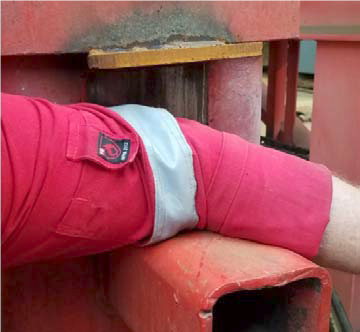Serious injury caused by energy isolation failure
What happened?
A yard worker was cleaning debris from underneath a hydraulic pipe. Whilst performing this task, the worker placed his forearm on a hydraulically operated pipe stand. This put the forearm in the line of fire between a lift pocket and a recently modified plate. A serious injury occurred to the worker’s forearm when the pipe stand (see photograph) was lowered by another worker operating the hydraulic lowering mechanism.

What went wrong? What were the causes?
- There were no energy isolation routines to prevent the lowering operation from occurring inappropriately, though this was covered and required by our members’ permit to work (PTW) system;
- There were simultaneous operations (SIMOPS) taking place and these presented risks which had not been properly assessed;
- There had been modification of this equipment and this had not been fully risk assessed;
- The task plan was not detailed enough to define all of the hazards in the work area;
- The injured person did not notice that his task placed him ‘in the line of fire’.
What actions were taken? What lessons were learned?
- All activities require a risk assessment. Where simultaneous operations have the potential to expose a person to harm, the PTW and isolation process should show that a higher level of control, communication and mitigation is in place;
- Use the MoC process to ensure that modifications to equipment are assessed and do not introduce a new hazard.
Members may wish to refer to the following:
- Fatal accident in connection with the operation of an A-frame based launch and recovery system (LARS) used for ROV operations (casual factor: failure of isolation)
- Inadvertent lowering of lifeboat (casual factor:failure to identify hazards)
- Serious finger injury: procedures during engine maintenance (injured person was in the line of fire)
- Line of fire (video)
- In the line of fire (video, IMCA SEL 036)
- Guidelines for management of change (IMCA SEL 001)
Safety Event
Published: 23 August 2018
Download: IMCA SF 18/18
IMCA Safety Flashes
Submit a Report
IMCA Safety Flashes summarise key safety matters and incidents, allowing lessons to be more easily learnt for the benefit of all. The effectiveness of the IMCA Safety Flash system depends on Members sharing information and so avoiding repeat incidents. Please consider adding safetyreports@imca-int.com to your internal distribution list for safety alerts or manually submitting information on incidents you consider may be relevant. All information is anonymised or sanitised, as appropriate.
IMCA’s store terms and conditions (https://www.imca-int.com/legal-notices/terms/) apply to all downloads from IMCA’s website, including this document.
IMCA makes every effort to ensure the accuracy and reliability of the data contained in the documents it publishes, but IMCA shall not be liable for any guidance and/or recommendation and/or statement herein contained. The information contained in this document does not fulfil or replace any individual’s or Member's legal, regulatory or other duties or obligations in respect of their operations. Individuals and Members remain solely responsible for the safe, lawful and proper conduct of their operations.
